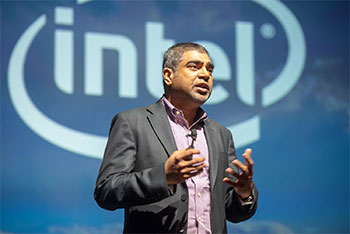Drone Technology: Leading the Data Revolution Written 29 June 2018
Speaker: Anil Nanduri, vice president and general manager, Drone Group, Intel Corp.
by Ben Iannotta, Aerospace America editor-in-chief

Intel, the computer chipmaker and drone pioneer, plans to one day program its drones to automatically spot trouble, such as a rusted pipe in an oil refinery, and text an alert to a manager on the ground.
Anil Nanduri, head of Intel’s Drone Group, described this as part of the company’s long-term vision in his June 29 presentation “Drone Technology: Leading the Data Revolution” at the 2018 AVIATION Forum in Atlanta.
For now, each of the company’s Falcon 8 Plus inspection drones must land so personnel can remove a data card for processing the images into 2D and 3D renderings.
“We developed an algorithm that automatically classifies these images” to identify possible defects in the infrastructure scanned, he said. The software compares the new images to previous images to look for changes. Intel ultimately wants to shift this process onto its drones, he said, explaining that each would automatically text “hey, I see a problem.”
Intel manufactures its own drones, Nanduri said, to ensure a seamless end-to-end process.
Nanduri played a video showing how a user can click through images of bridges, refineries, chemical factories or other infrastructure in both 2D and 3D and be automatically alerted to changes, such as progression of rust in the case of a bridge or factory. Another video showed an operator on a research ship controlling a drone to count polar bears on a rocky shore as part of a climate change study. The infrared signatures of the bears glowed brightly on a computer screen. Intel drones are also flown for crop monitoring, he said.
For infrastructure inspection, a pilot is on hand, but “the computer is actually flying the aircraft,” Nanduri said, adding that in the future, that “will be fully autonomous.” Precision flight and autonomy are critical, he said, because this ensures the data is “repeatable” and “accurate” for purposes of detecting changes in complex structures without human inspectors flying in helicopters or dangling from tethers.
“Once you have this [imagery] data digitized, it’s going to be amazingly powerful,” he said.
During the question and answer section, the online audience raised the specter of the Facebook data-sharing case and asked about the privacy issues raised by drones taking fine-resolution images that are stored in databases.
Nanduri said there are rules to protect privacy, although he said he understands the concern.
“At the end of the day, the data belongs to the customer, and the customer has to be aware of how the data is going to be used,” he said. “That’s an important point.”
After the talk, Nanduri said the company has an FAA waiver to conduct flights below 400 feet in the U.S. and sometimes requests waivers for higher altitude flights.
